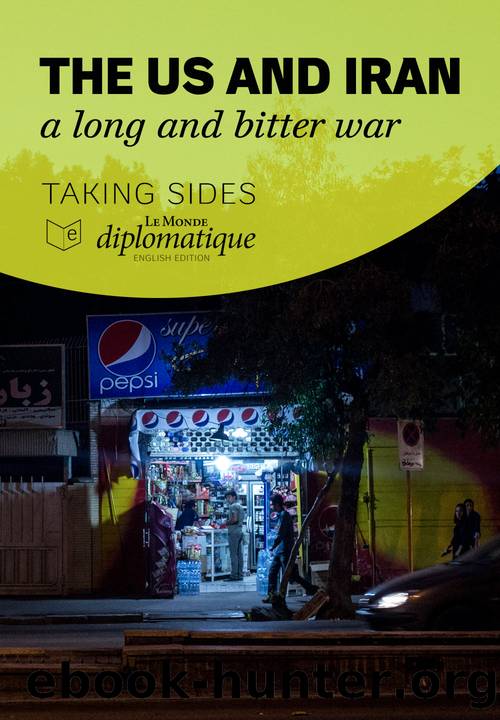The US and Iran: a long and bitter war by Le Monde diplomatique

Author:Le Monde diplomatique
Language: fra
Format: epub
Publisher: Le Monde diplomatique
Published: 2020-01-21T00:00:00+00:00
Tradition of political opposition
Shia minorities in Kuwait, Saudi Arabia and Bahrain have a long tradition of domestic political opposition, as shown by the supporters of Ayatollah Muhammad al-Shirazi in Kuwait. Though they enjoyed Iranian support, they distanced themselves from the Islamic Republic, which was interfering in their efforts to build a unified national opposition.
In Afghanistan, Iran has always supported the Shia Hazara with religious and military training and humanitarian aid. But the Hazara are not an important minority, and Iran needs the help of the Farsi-speaking Sunni Tajiks to counter the Taliban. In Syria, where there are 10,000 foreign fighters â including 2-3,000 Iranians, most from the Al-Quds special forces â Shia from Afghanistan and Pakistan have supplied many fighters.
The heterodox Zaydi Shia minority in Yemen had no links with Iranians, who are of a different (Twelver) Shia tradition. But the Houthi uprising has united them against Saudi Arabia and its armed intervention in Yemen, giving Iran an opportunity to counter Saudi policy in Syria.
Relations with Iraq are far more complex. The great Shia religious schools and holy places are in the Iraqi cities of Najaf and Kerbala, rather than in Qom or Mashad in Iran. The rivalry between Persian and Arab Shiism is intensified by the antagonism between Iran and Iraq, and by Grand Ayatollah Ali al-Sistani, very influential in Iraq, and his opposition to the Iranian principle of velayat-e faqih (guardianship of the Islamic jurists), which gives the clergy the leading role. The US invasion of Iraq in 2003 and overthrow of Saddam Hussein allowed Iran to build a tentative good-neighbour relationship with Iraq; this was based on support for the new Shia-majority government, strong trade relations, and powerful influence networks and militias. But this Iranian presence clashes with Iraqi nationalism, still strong after a century of independence, central government under the Baath Party, and the eight-year war against Iran which reinforced the old divide between the Ottoman and Safavid empires.
Iraqâs prime minister Haider al-Abadi is glad of the development of economic ties with Iran and the support of the Al-Quds forces and Shia militias in the fight against ISIS. But he is now trying to assert his independence. Forces directly controlled by Iran played little part in the liberation of Mosul, achieved largely by the Iraqi armyâs Golden Division. Iranâs emphasis on national defence makes it cautious, so all it can safely do is consolidate its influence along the border, in Shia holy cities from Basra to Kurdistan, while supporting Iraq in its quest for unity and stability.
Syria has almost no true Shia population. The Alawites were officially designated as Shia under President Hafez al-Assad (1971-2000) to strengthen the alliance between Syria and Iran. After Yasser Arafat, Assad was the first leader to visit the new Islamic Republic. This alliance has lasted through all the wars, notably the fight against ISIS. Iran feared that ISIS victories in Syria and Iraq would create a huge territory on its borders directly or indirectly dominated by Saudi Arabia and the Gulf states.
Download
This site does not store any files on its server. We only index and link to content provided by other sites. Please contact the content providers to delete copyright contents if any and email us, we'll remove relevant links or contents immediately.
| Bahrain | Egypt |
| Iran | Iraq |
| Israel & Palestine | Jordan |
| Kuwait | Lebanon |
| Oman | Qatar |
| Saudi Arabia | Syria |
| Turkey | United Arab Emirates |
| Yemen |
Empire of the Sikhs by Patwant Singh(22176)
The Wind in My Hair by Masih Alinejad(4427)
The Templars by Dan Jones(4192)
Rise and Kill First by Ronen Bergman(4017)
The Rape of Nanking by Iris Chang(3522)
12 Strong by Doug Stanton(3059)
Blood and Sand by Alex Von Tunzelmann(2611)
The History of Jihad: From Muhammad to ISIS by Spencer Robert(2210)
Babylon's Ark by Lawrence Anthony(2073)
No Room for Small Dreams by Shimon Peres(1992)
The Turkish Psychedelic Explosion by Daniel Spicer(1990)
Gideon's Spies: The Secret History of the Mossad by Gordon Thomas(1953)
Inside the Middle East by Avi Melamed(1945)
The First Muslim The Story of Muhammad by Lesley Hazleton(1885)
Arabs by Eugene Rogan(1837)
Bus on Jaffa Road by Mike Kelly(1786)
Come, Tell Me How You Live by Mallowan Agatha Christie(1771)
Kabul 1841-42: Battle Story by Edmund Yorke(1650)
Citizen Strangers by Robinson Shira N.;(1536)
